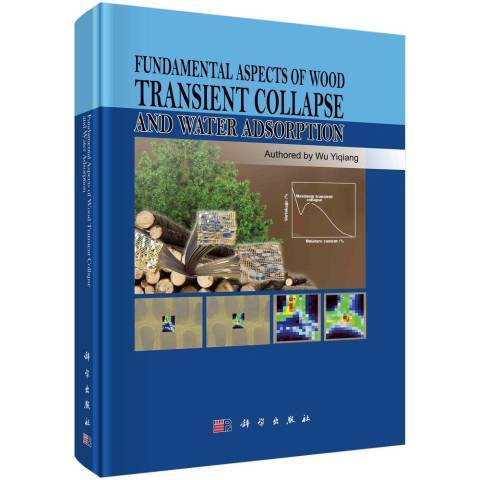《Fundamental aspects of wood transient collapse and water adsorption》是2021年科學出版社出版的圖書。
基本介紹
- 中文名:Fundamental aspects of wood transient collapse and water adsorption
- 作者:吳義強
- 出版時間:2021年
- 出版社:科學出版社
- ISBN:9787030673664
- 類別:林業
- 開本:16 開
- 裝幀:精裝
內容簡介,圖書目錄,
內容簡介
本書介紹了人工林木材的儲備、發展狀況和保護木材安全的重要性,敘述了人工林木材幹燥皺縮及收縮以及水分吸附基礎理論。本書以桉樹為代表,歸納了人工林木材的解剖學結構、變色特性、水分吸收特性等性質與木材幹燥皺縮之間的關係,闡述了間歇式乾燥對人工林木材細胞微觀形貌的影響規律,總結了採用間歇式乾燥減小人工林木材幹燥皺縮及收縮程度的**工藝。
圖書目錄
Contents
Chapter 1 Overview 1
1.1 A brief introduction to wood resources 1
1.1.1 International wood resources 1
1.1.2 China’s wood resources 1
1.2 General drying theory and technology 2
1.2.1 Wood-water relations 2
1.2.2 Wood drying theory 12
1.2.3 Wood drying technology 13
1.3 Drying theory and technology related to wood collapse 16
1.3.1 Fundamental properties related to wood collapse 16
1.3.2 Prediction and assessment of wood collapse 20
1.3.3 Traditional wood collapse theory 22
1.3.4 Novel wood transient collapse theory 23
1.3.5 Drying technology for minimizing collapse 24
1.4 Summary 30
References 31
Chapter 2 Anatomical Characteristics vs. Shrinkage and Collapse 41
2.1 Introduction 41
2.2 Materials and methods 42
2.2.1 Collection of sample woods 42
2.2.2 Preparation of specimens 42
2.2.3 Determination of unit shrinkage (α), total shrinkage and residual collapse 43
2.2.4 Measurement of basic density 43
2.2.5 Determination of microfibril angle (MFA) 44
2.2.6 Determination of both fiber morphology and various tissues proportion 44
2.2.7 Statistics analysis 44
2.3 Results 45
2.3.1 Statistics on various indices 45
2.3.2 Correlation analysis 46
2.3.3 Regression analysis 47
2.4 Discussions 48
2.4.1 Relationship between basic density and unit shrinkage and total shrinkage 48
2.4.2 Relationship between basic density and residual collapse 49
2.4.3 Relationship of anatomical characteristics to unit shrinkage and total shrinkage 50
2.4.4 Relationship between anatomical characteristics and residual collapse 50
2.5 Conclusions 52
References 52
Chapter 3 Colorimetric Characteristics vs. Shrinkage and Collapse 55
3.1 Introduction 55
3.2 Material and methods 57
3.2.1 Preparation of specimens 57
3.2.2 Steaming and drying procedure 58
3.2.3 Non-collapse shrinkage tests 58
3.2.4 Determination of total shrinkage, normal shrinkage and collapse by image analysis technique 59
3.2.5 Measurements of color parameters 59
3.2.6 Regression analysis 60
3.2.7 Measurement of NIR 60
3.3 Results and discussions 60
3.3.1 Effects of drying temperatures on shrinkage and collapse properties 60
3.3.2 Effects of steaming treatments on shrinkage and collapse properties 62
3.3.3 Effects of combination of various heat and steaming treatments on both shrinkage and collapse 63
3.3.4 Shrinkage and collapse properties-colorimetric parameters relationships when subjected to various heat treatments 64
3.3.5 Shrinkage and collapse values-colorimetric parameters relationships when subjected to various steaming treatments 65
3.3.6 Shrinkage and collapse values-colorimetric parameters relationships when subjected to combination of heat and steaming treatments 67
3.3.7 Effect of steaming time on sample coloring 68
3.3.8 Effect of drying process on sample coloring 70
3.4 Conclusions 73
References 74
Chapter 4 Water Vapor Sorption Behavior vs. Shrinkage and Collapse 77
4.1 Introduction 77
4.2 Materials and methods 79
4.2.1 Preparation of specimens 79
4.2.2 Heating and steaming procedure 80
4.2.3 Non-collapse shrinkage tests 81
4.2.4 Determination of total shrinkage, normal shrinkage and collapse by image analysis technique 81
4.2.5 Determination of water vapor sorption behavior 81
4.3 Results and discussion 82
4.3.1 Water vapor sorption behavior 82
4.3.2 Sorption hysteresis 85
4.3.3 Sorption kinetics 87
4.3.4 The applicability of Kelvin-Voigt model 93
4.4 Conclusions 97
References 98
Chapter 5 Drying Conditions vs. Shrinkage and Collapse 102
5.1 Introduction 102
5.2 Materials and methods 103
5.2.1 Preparation of specimens 103
5.2.2 Continuous drying procedures 103
5.2.3 Intermittent drying procedures 104
5.2.4 Measurement of dimension by image analysis technique 104
5.2.5 Determination of total shrinkage and residual collapse 104
5.2.6 SEM observation 105
5.2.7 Advancement of novel concepts of both transient collapse and maximum transient collapse 106
5.3 Results and discussion 107
5.3.1 Characteristics of wood tissue structure changes in the drying process under the continuous and intermittent drying regimes 107
5.3.2 Comparison of collapse-shrinkage characteristics under the continuous and intermittent drying regimes 108
5.3.3 Analyses of radial variation characteristics in collapse-shrinkage properties under the continuous and intermittent drying regimes 110
5.4 Conclusions 111
References 112
Chapter 6 Morphological Study of Collapsed Wood Cells in Intermittent Drying 114
6.1 Introduction 114
6.2 Materials and methods 115
6.2.1 Materials 115
6.2.2 Drying conditions 115
6.2.3 Collapse-type shrinkage curve 116
6.2.4 Preparation of micro section and SEM observation 117
6.3 Results and discussion 117
6.3.1 Effects of different drying schedule on drying progression 117

